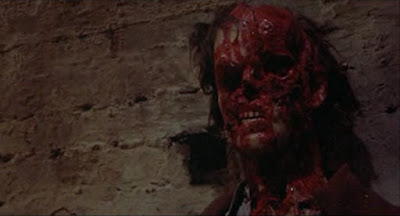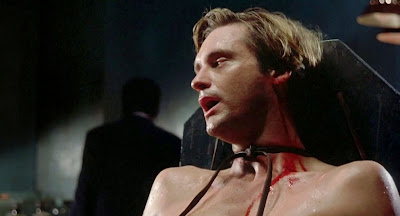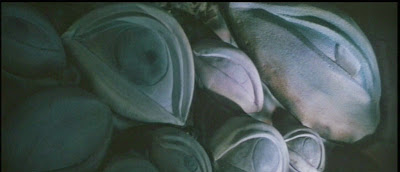One of the challenges involved with creating a project like a list is writing from distant memories rather than from fresh impressions. I rarely write about films I haven't seen in a while. In the case of some of the films I'm listing here, my impressions are decades old. It would be completely impractical to rewatch all of these films, though I imagine that most of them stand up to rewatching. The only film I've rewatched for these posts is The Queen of Spades, listed below. Others? I haven't seen The Serpent and the Rainbow since it was in theaters, nor have I seen The Other since it creeped me out of me when I was a kid, watching it on late night television. I've never forgotten any of these films, though, which it a testament to their quality.
The Serpent and the Rainbow (1988, directed by Wes Craven)
Even though it includes some Nightmare on Elm St.-style games with the set of reality, The Serpent and the Rainbow represents a departure for director Wes Craven. Indeed, it's one of his most ambitious horror films. Craven eschews his usual post-modern noodling in this to tell the story of Wade Davis, a botanist investigating the so-called "zombie drug" in Haiti during the last days of the Duvalier regime. This is a "true" story, as the saying goes. The recreation of Haiti in turmoil contributes a huge dollop of menace, while the movie stages a couple of set-pieces that echo deep in the hindbrain. One of these is a memorable riff on the coffin with a window from Dreyer's Vampyr. Another finds Davis abducted by the Tonton Macoute, Duvalier's secret police. This last is the most frightening thing in Craven's filmology. The punch line, when Davis tells Cathy Tyson's doctor character that he knew they wouldn't kill him because they only drove the spike through his scrotum, is magnificent. Oh, Craven can't help himself when he films some hallucinations, but these are a concession to the horror movie that seem extraneous to me. When the film keeps its eye on "reality," (whatever that is), it's electrifying.
The Queen of Spades (1949, directed by Thorold Dickinson)
The influence of the Val Lewton films first manifested itself in the U.K. right after the end of the war. Dead of Night, the great anthology film, is one film to bear that stamp. The Queen of Spades, unjustly neglected for decades now, is another. It's a film of dense, eye-deceiving visual splendor and elegant sleight of hand. Archers favorite Anton Walbrook plays a Russian officer looking for the secret to winning at cards allegedly in the possession of an aging countess, who sold her soul to the devil. This is a film whose best effects rely on directing and misdirecting the eye. It's a film where significant images are reflections, paintings, dolls, and where the drama doesn't reside in the huggermugger of genre tropes, but in the eyes of its actors. Walbrook is cold and calculating, and he's well matched by Edith Evans, who may or may not be in league with the devil. It's a deliciously ambiguous film.
Rogue (2007, directed by Greg Mclean)
There have been a lot of movies about giant crocodiles and alligators over the years, but very few of them match the menace of this unassuming survival horror movie. Australia has a reputation for wanting to kill people who stray from the beaten path and that's true of this movie as a boat full of tourists is set upon by a gigantic croc. As our marooned protagonists try to extricate themselves from the island on which they're trapped, the croc picks them off one by one. This is ostensibly based on a true story, but the end, in which our hero descends into the lair of the beast, has mythic resonance. It's Beowulf vs. Grendel's mother in Australian drag and it's wonderful.
May (2002, directed by Lucky McKee)
True, May is ostensibly a horror movie: it delivers the goods a horror movie is supposed to deliver. It has a baroque, violent setpieces at the end that will surely satisfy even the most jaded horror fans. But its beats as a horror movie come after a long first two acts in which the film gets under the viewer's skin in a much more subtle and much more distressing manner. May's spiritual sister is Carrie White (a role played by star Angela Bettis for the television remake of Carrie), a downtrodden, lonely girl whose anger at her own heartbreak turns apocalyptic. May's concerns are the concerns of a lonely woman. Her dementia is a particularly feminine dementia. May's horrors are the horrors of relationships, not of carnage. Watching these horrors unfold is immensely more unsettling than the film's bloodstained denouement. After watching May's disastrous last date with Adam, the dismemberments of the last quarter of the movie are almost a relief. Almost. The ending, the very last shot, pushes the film out of the realm of the psychotic monstrous feminine of a Repulsion or a Heavenly Creatures and into the realm of the fairy tale. A ghastly, haunting fairy tale, as it so happens.
Blind Beast (1969, directed by Yasuzo Masumura)
It's easy--too easy--to compare Blind Beast to John Fowles's The Collector. The kidnapping and the psychotic sexual tension is certainly similar. But that would be a mistake. Blind Beast derives, instead, from the much weirder, much kinkier Edogawa Rampo, who wrote this story in the 1930s. Masumura strips it down to its essentials: the blind sculptor and the "model" he's kidnapped. This is a film with a short-circuited gaze. The sculptor sees with his hands and the film obliges by providing sensuous surfaces and fragmented body parts. We're not used to seeing in this way, although I would suggest that it's still an example of a male gaze. It's disorienting. Perversely, it's visually sumptuous in spite of a confined location and a tight focus on only two characters. It's almost theatrical. It's also a forerunner of the pinky violence films that would shortly take over the Japanese studio system and evidence that pornography can indeed also be art.

Raw Meat (1973, directed by Gary Sherman)
A variant of the Sawney Bean myth concerning a family of inbred cannibals inhabiting the London Underground, Raw Meat represents the arrival of the splatter movie in the U.K. Like its trans-Atlantic cousins, it brings social critique with the grue, as its cannibals can be seen as working class morlocks to the established order of late twentieth "progress." It bids farewell to the old-style British Gothic in the form of Donald Pleasance and Christopher Lee, who trace the mystery. It's the cannibals who have the last word, though, both in the ferocity of their violence and in the film's magnificent punch line. "Mind the doors...!"
Thirst (1979, directed by Rod Hardy)
I'm fond of the horror movies of the Ozploitation boom of the 1970s. I knew that I wanted to include a representative, but I dithered over which film. The conventional choice would have been Patrick, a film that has a considerable cult, though I don't much like it, myself. I could have put The Long Weekend or The Survivor here, and felt good about it. Ultimately, I chose Thirst for personal reasons. It's one of those films I discovered late at night in the early days of HBO and then again in the mid-Nineties when I stumbled upon a copy of it in the stacks of a used videotape distributor. I never forgot the film's imagery, whether the big "milking" machines the film's cult of vampires use to harvest blood for their members or the Wile E. Coyote-ish death of Henry Silva's character on some power lines or the heroine's final capitulation to the indoctrination she's been resisting all movie. It's a strange film, but one with a crude power behind its strangeness.
The Other (1972, directed by Robert Mulligan)
An example of the early 70s American Gothic, which favored creeps instead of gore, this one adds a haunting kind of nostalgia to the mix. The creepiness of twins is played up in this tale of good and bad twins, though one of the twins is already dead by the time the film starts. Like other films of its ilk, this one favors ambiguity and an unreliable narrative. As an inheritor of the 1960s, it also indulges in the trope of evil children, which was creepy when it was first deployed even if it's a cliche now. Director Robert Mulligan was good at Bradbury-esque evocations of childhood (he also directed To Kill a Mockingbird), but he's clear-eyed about the capacity for violence children carry within them.
Rituals (1976, directed by Peter Carter)
Brutal survival horror movie modeled on Deliverance, in which a group of doctors head into the wilderness on holiday only to be picked off one by one by an unseen stalker. Like most good films to use this trope, this tests its characters to destruction to see how they tick. The fact that the characters here are all middle aged with nary a nubile young woman in sight is unusual enough, but this is a movie in which masculinity itself is fodder for the crucible. Hard to find on home video, but worth the effort.
Livid (2011, directed by Alexandre Bustillo and Julien Maury)
A catalogue of horror movie tropes assembled into something like poetry, this is a dream fugue of a movie that has more in common with the surrealists than it does with any tradition derived from genre. It's more Cocteau than George Romero, even as it plays around with the toys Romero pioneered. This is a post-modern film, too, which rewards horror fans even as it frustrates their expectations. This is violent, which is unsurprising given the filmmakers' pedigree, but its best images don't rely on violence. What IS surprising is that a film by two male directors would be so concerned with the female gaze. Men are marginalized in this movie to an extraordinary extent, all while plunging the audience into a world ruled by the concerns of women and the artful savagery that can entail.
There's still more to come before we launch into the October Challenge proper. I hope you've stockpiled cider and candy and horror movies for the event. Come back tomorrow for the last installment. All good things, and all that...

I'm trying out Patreon as a means of funding my blogs. They don't have a widget yet, so this link will just have to do. If you like my writing and art and if you'd like to support Krell Laboratories and Christianne's Art and Comics, please come on over and pledge. Thanks.


























No comments:
Post a Comment